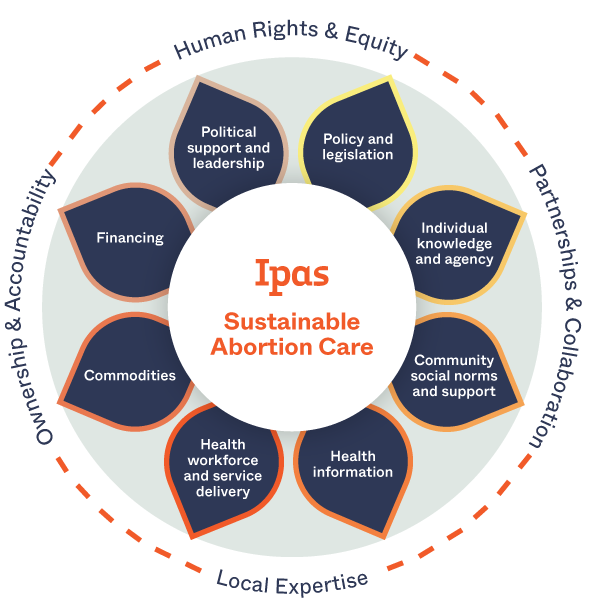Archives: Resources
Unsafe abortion’s significant contribution to maternal mortality and morbidity was a critical factor leading to liberalization of Nepal’s restrictive abortion law in 2002. Careful, comprehensive planning among a range of multisectoral stakeholders, led by Nepal’s Ministry of Health and Population, enabled the country subsequently to introduce and scale-up safe abortion services in a remarkably short timeframe. This paper examines factors that contributed to rapid, successful implementation of legal abortion in this mountainous republic, including deliberate attention to the key areas of policy, health system capacity, equipment and supplies, and information dissemination.
Two major women’s health organizations, Susan G. Komen for the Cure and Planned Parenthood, battled for women’s respect and donations. Two days later the dust is settling and we’re left to wonder what we should take away from the tangle? Was it about fundraising? Women’s health? Politics? I suggest it is about stigma, specifically abortion stigma that has been deliberately attached to a beloved national institution and household name, Planned Parenthood.
Implementation of legal abortion in Nepal: A model for rapid scale-up of high-quality care The case of Purvi Patel, a young woman in Indiana sentenced to 20 years in prison for feticide and child neglect, is a grotesque example of abortion stigma.
Available Here Implementation of legal abortion in Nepal: A model for rapid scale-up of high-quality care Women’s human rights are enshrined in globally recognized agreements — including the United Nations Convention on the Elimination of All Forms of …
Available Here Implementation of legal abortion in Nepal: A model for rapid scale-up of high-quality care Violence against women is one of the most pervasive human rights violations in the world. Globally, more than one in three women have experienced …
Available Here Implementation of legal abortion in Nepal: A model for rapid scale-up of high-quality care The movement of Muslim women’s activists upends American stereotypes about the role of women in Islam, and shows that they set a path of activism …
Available Here Implementation of legal abortion in Nepal: A model for rapid scale-up of high-quality care The year 2015 marks a critical point in international work on health and development. We are at a key juncture for three highly relevant global ef …
Available Here Implementation of legal abortion in Nepal: A model for rapid scale-up of high-quality care El año 2015 marca un punto crítico en el trabajo internacional en salud y desarrollo. Nos encontramos en un momento clave de tres esfuerzos altame …
Available Here Implementation of legal abortion in Nepal: A model for rapid scale-up of high-quality care In Nepal, following the liberalization of the abortion law, expansion and scaling up of services proceeded in parallel with efforts to create awar …
Available Here Implementation of legal abortion in Nepal: A model for rapid scale-up of high-quality care In too many countries around the world, abortion is criminalized, stigmatized, or otherwise restricted. Although pregnancy termination is one of t …
Maternal mortality in Sierra Leone is one of the highest in the world and complications from unsafe abortion are one of the leading causes. This article reports the results of a 2012 study to assess the impact and costs of treatment of abortion complications on the country’s public health system, and estimate the costs of a shift to safe, legal abortion. The study concludesdthat a shift to safe, legal abortion would dramatically reduce the current costs of PAC.
The primary study aim was to describe patient satisfaction regarding abortion experiences in urban academic family medicine centers (FMCs). We conducted a cross-sectional survey of 210 women obtaining a first trimester medication or aspiration abortion at four FMCs. The majority of women (93%) were very satisfied with their abortion experience in their FMC, regardless of clinical site or abortion method. Women most commonly cited positive interactions with the staff and physicians as the best part of their experience. This study demonstrates that women who receive abortion services at academic FMCs are highly satisfied with their care.
Despite liberalization of the Nepal abortion law, young women continue to experience barriers to safe abortion services. This study evaluated differences in reproductive knowledge and attitudes by marital status. Participants were surveyed on demographics, romantic experiences, media habits, reproductive information, and abortion knowledge and attitudes. Only 45% responded that they knew that abortion was legal, and fewer ever-married women were aware of abortion legality. Never-married women expected more negative responses from having an abortion than ever-married women. Findings highlight the need for providing sexual and reproductive health care information and services to young women regardless of marital status.
In order to narrow the gap between the promise and realization of African women’s right to reproductive health care, the African Commission on Human and Peoples’ Rights adopted General Comment No. 2 last year, releasing it online earlier this month. The document was drafted under the guidance of Commissioner Soyata Maiga, Special Rapporteur on the Rights of Women in Africa, with technical support from the Ipas Africa Alliance and input from numerous reproductive rights and legal experts throughout the region.
This study describes postabortion complication severity and associated factors in Kenya. A nationally representative sample of 326 health facilities was included in the survey. Data were collected from 2,625 women presenting with abortion complications.
The African Commission on Human and Peoples’ Rights recently adopted General Comment No 2 to interpret provisions of Article 14 of the Protocol to the African Charter on the Rights Women.
Implementation of legal abortion in Nepal: A model for rapid scale-up of high-quality care Although Cambodia now permits elective abortion, scarcity of research on this topic means that information on abortion incidence is limited to regional estimates …
Background: the grounds for the legal termination of pregnancy in the Mexican Republic vary according to the provisions of the Constitution of each state; as of 2007 it is legal in Mexico City. Objective: to identify the knowledge, attitudes and practice of abortion among gynecologists and obstetricians. Conclusions: it is necessary to increase and improve technical and legal knowledge about abortion, especially among OB / GYNs, who are responsible for complying with what the law indicates, in accordance with international recommendations and the exercise of the reproductive rights of the woman.
A comprehensive structured program design, collaboration between the MOH and Ipas, and provider dedication enabled successful introduction of second-trimester abortion services in major regions/states of Ethiopia. A focus on second- trimester medical abortion allows for rapid service introduction without extensive changes to facilities, equipment, or staffing as the needs are similar to obstetric care.
Guidance for postabortion care (PAC) is established for the first trimester but limited in the second trimester. Objective: To establish evidence-based recommendations for PAC in the second trimester. Conclusion: Misoprostol with or without mifepristone is an effective treatment for second-trimester PAC. The minimum misoprostol dose is 200 μg vaginally, sublingually, or buccally every 6–12 hours.

